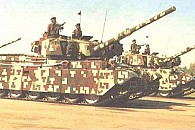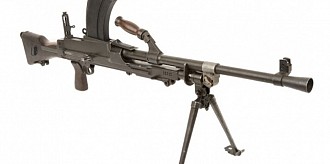Combat vehicles / Main battle tanks / Vickers MBT
Vickers MBT
General Facts
- TYPE
Main battle tank - ORIGIN
 United Kingdom
United Kingdom - NICKNAMES
Vijayanta (Indian nickname) - DESIGNED
Early 1960's - DESIGNER
Vickers - PRODUCTION
1965 - 1995 - PRODUCERS
 India - Avadi
India - Avadi
 United Kingdom - Vickers
United Kingdom - Vickers - QUANTITY
About 2.500 produced. - UNIT COST
$ 1.6 million - CHARACTERISTICS
 Good firepower
Good firepower
 Simple and reliable design
Simple and reliable design
 Limited production costs
Limited production costs
 Limited armor protection
Limited armor protection
 Low speed
Low speed
Introduction
The Vickers MBT is a main battle tank of UK origin. It was developed by Vickers in the early 1960's for export sales. The Chieftain that was developed for the UK army would be too heavy and far too costly for export to Asia and Africa. The Vickers MBT was developed as a budget tank and uses various components of the Centurion and Chieftain designs.
Layout
The Vickers MBT has a conventional layout. The driver is seated in the front. The turret is placed in the middle and seats the commander, gunner and loader. The engine and drive train are placed at the rear. Many automotive parts are also used on the Chieftain. Sleek straight side skits make the Vickers MBT easy to recognize. The original Mk 1 has a squared turret with large gun mantlet. The Mk 3 has a cast turret and various other improvements, including a more powerful engine. Based on the same chassis a recovery vehicle and bridgelayer were developed.
Firepower
The main armament of the Vickers MBT is the 105mm L7 rifled cannon. The proven L7 cannon provides serious punch and has good accuracy. Against modern main battle tanks the L7 is of limited use, but it is more than adequate for the threats the users of the Vickers MBT face. A 7.62mm machine gun is installed as a coaxial weapon and a 12.7mm ranging machine gun aids in firing the main gun. An additional 7.62mm machine gun is fitted on the turret roof for anti-aircraft use.
Protection
For a main battle tank the Vickers MBT has poor armor protection. The steel armor is up to 80mm thick at the turret front, 60 to 80mm thick at the hull front and 20 to 40mm at the hull sides. This provides the crew protection from small arms fire and shell splinters all around and autocannon and weak anti-armor weapons over the frontal arc. An NBC system is present as are smoke grenade dischargers.
Mobility
The Vickers MBT has a reasonable mobility. The maximum speed is rather limited, being below 50 km/h. The tracked chassis and reasonable power to weight ratio ensure a good off road capability. The Mk 1 uses a 650 hp multifuel engine while the Mk 3 uses a 720 hp turbocharged diesel engine.
Users
The first and main user of the Vickers MBT is India. About 2.200 were produced in India and over 500 remain in service today. They are to be replaced by newer models. The second nation to order was Kuwait. From 1977 to 1995 batches were acquired by various African nations.
Vickers Mk 3
Vickers Mk 1: The Vickers Mk 1 is the first production model of the Vickers MBT. It features a squared box-like turret with large gun mantlet. The Leyland L60 multifuel engine that was developed for the Chieftain provides propulsion. The Vickers Mk 2 was to be a Mk 1 fitted with a Swingfire missile on each side of the turret. The Mk 2 was never put in production.
Vickers Mk 3: The Vickers Mk 3 is a much improved version of the Vickers MBT. The Mk 3 features a cast turret, more powerful engine, a commander's cupola and laser range finder. It also carries more ammunition and has improved fire controls.
- Specifications:
- Vickers Mk 3
| Type | Main battle tank |
|---|---|
| Crew | 4 (commander, driver, gunner, loader) |
| Length | 7.65 m (hull), 9.79 m (gun forward) |
| Width | 3.17 m |
| Height | 2.48 m (turret roof), 3.10 m (without MG) |
| Ground clearance | 0.41 m |
| Weight | 36.1 t unloaded, 38.7 t combat load |
| Ground pressure | 0.88 kg/cm2 |
| Wheelbase | Tracked chassis, 6 roadwheels, idler front, drive sprocket rear, 4.28 m length, 0.52 m width, 2.52 m track |
| Turn radius | ? |
| Engine | Detroit Diesel 12V-71T V12 diesel, 720 hp at 2.500 rpm |
| Power ratio | 18.6 hp/t |
|---|---|
| Transmission | David Brown TN12 automatic, 6 forward, 2 reverse |
| Speed | 50 km/h |
| Fuel | 1.000 L |
| Range | 490 km |
| Wall | 0.9 m |
| Trench | 2.4 m |
| Gradient | 60% gradient, 30% slope |
| Fording | 1.1 m |
| Armor | Steel |
| NBC equipment | Yes |
| Night vision | Yes |
|---|---|
| Smoke | 2x6 smoke grenade dischargers |
| Remarks | - |
| Armament | 105mm L7 cannon 7.62mm coaxial MG 12.7mm ranging MG 7.62mm roof MG |
| Weapon1 | 105mm L7 cannon in turret 50 rounds, 18 ready to fire -7 to +20° elevation, powered 360° traverse, 24°/s powered stabilized in both axis |
| Weapon2 | 7.62mm coaxial machine gun 2.400 rounds in total traverse and elevation as main armament |
| Weapon3 | 12.7mm ranging machine gun 700 rounds traverse and elevation as main armament |
| Weapon4 | 7.62mm machine gun on turret roof 2.400 rounds in total manual traverse and elevation non-stabilized |
| Weapon5 | - |
| Weapon6 | - |
Vickers ARRV
Vickers ARRV: The Vickers Armored Repair and Recovery Vehicle is based on the Vickers MBT chassis. Instead of a turret it has an armored superstructure that houses the crew. The engineering equipment includes a 25 t winch, an earth anchor and a 4 t crane. A 7.62mm machine gun is fitted for self defense. In India a recovery version based on the Vickers chassis was also developed. It features a box shaped superstructure and has an A-frame instead of a crane.
- Specifications:
- Vickers ARRV
| Type | Armored recovery vehicle |
|---|---|
| Crew | 4 (commander, driver, 2 engineers) |
| Length | 7.56 m (hull), 8.38 m (with spade) |
| Width | 3.16 m |
| Height | 2.89 m (overall) |
| Ground clearance | 0.43 m |
| Weight | 38.0 t combat load |
| Ground pressure | 0.79 kg/cm2 |
| Wheelbase | Tracked chassis, 6 roadwheels, idler front, drive sprocket rear, 4.28 m length, 0.52 m width, 2.52 m track |
| Turn radius | ? |
| Engine | Detroit Diesel 12V-71T V12 diesel, 720 hp at 2.500 rpm |
| Power ratio | 18.9 hp/t |
|---|---|
| Transmission | David Brown TN12 automatic, 6 forward, 2 reverse |
| Speed | 50 km/h on road |
| Fuel | 1.000 L |
| Range | 600 km on road |
| Wall | 0.9 m |
| Trench | 3 m |
| Gradient | 60% gradient, 30% slope |
| Fording | 1.1 m |
| Armor | Steel |
| NBC equipment | ? |
| Night vision | ? |
|---|---|
| Smoke | ? |
| Remarks | 25 t winch, 4 t winch, earth anchor, 4 t crane |
| Armament | 7.62mm MAG machine gun |
| Weapon1 | 7.62mm L37A1 (MAG) machine gun on commander's cupola 100 rounds ready to fire -10 to +90° elevation, manual 360° traverse non-stabilized |
| Weapon2 | - |
| Weapon3 | - |
| Weapon4 | - |
| Weapon5 | - |
| Weapon6 | - |
Vickers AVLB
Vickers AVLB: The Vickers armored bridgelayer is based on the Vickers MBT chassis. Instead of a turret it carries a single piece 13 m MLC 60/70 bridge which it can launch and recover using the front mounted frame. During launch and recovery the frame rests on the ground.
Kartik: The Kartik is an AVLB developed in India and is based on the lengthened Vickers chassis that is also used for the Catapult self propelled gun. It uses a BLG-60 type 20 m scissor bridge and has a different method for launching the bridge than the original Vickers AVLB.
- Specifications:
- Vickers AVLB
| Type | Vehicle launched bridge |
|---|---|
| Crew | 3 (commander, driver, engineer) |
| Length | 13.7 m (with bridge) |
| Width | 4.16 m (with bridge) |
| Height | 3.25 m (with bridge) |
| Ground clearance | 0.43 m |
| Weight | 43.9 t with bridge |
| Ground pressure | ? |
| Wheelbase | Tracked chassis, 6 roadwheels, idler front, drive sprocket rear, 4.28 m length, 0.52 m width, 2.52 m track |
| Turn radius | ? |
| Engine | Detroit Diesel 12V-71T V12 diesel, 720 hp at 2.500 rpm |
| Power ratio | 16.4 hp/t |
|---|---|
| Transmission | David Brown TN12 automatic, 6 forward, 2 reverse |
| Speed | ? |
| Fuel | 1.000 L |
| Range | 600 km on road |
| Wall | 0.9 m |
| Trench | 3 m |
| Gradient | 60% gradient, 30% slope |
| Fording | 1.1 m |
| Armor | Steel |
| NBC equipment | ? |
| Night vision | ? |
|---|---|
| Smoke | ? |
| Remarks | 13.4 m MLC 60 bridge |
| Armament | 7.62mm MAG machine gun |
| Weapon1 | 7.62mm L37A1 (MAG) machine gun on roof 100 rounds ready to fire manual traverse and elevation non-stabilized |
| Weapon2 | - |
| Weapon3 | - |
| Weapon4 | - |
| Weapon5 | - |
| Weapon6 | - |











